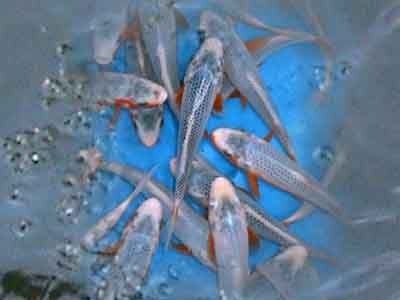The important viewing points of Asagi Koi are conspicuously vivid appearance of the meshes and light blue, spotless head region. However, as they age, black spots often appear in the head region and Hi (red) on the belly tend to climb up reaching as far as the back.
Selecting Asagi Koi
Here are some ideas to keep in mind in the selection process. Asagi Koi gain red year after year. So if you only select tosai that are perfectly marked at one year old, in all likely hood you will end up with a koi that has too much red in the end. The end you say? Well Asagi Koi does not come into its own until the age of three. That’s when the blue back and white fukurin establish themselves. It’s at this time you truly know what you have. So let’s focus on what we can tell with the koi at hand. The easiest job is to take the available koi for inspection and collect them all in a blue bowl. Remove all koi that do not have straight spines and all of their fins. In body shape look for the koi that shows a deeper shoulder than their brothers or sisters. The first thing we look for is white noses. The forehead will be a grey color, but not to worry; by the age of three it will clear up. The area I refer to as the nose is from the end of the mouth back to a line drawn between the two eyes. Return the koi that don’t make this cut.Next look at the gill cover of Asagi Koi .We want to find red completely encircling the gill cover in what I would describe as a narrow donut affair. If not found look for red at the underside of the gill plate up about a third of the way.
The next critical area of Asagi Koi is the red on the belly.The Japanese refer to this red with a word that translates ship’s red bottom. The appropriate red can best be described as an intense reddish orange. However I have seen blood red and while not the standard still incredibly beautiful! Here’s where it gets difficult. Depending on the breeder and the genes used, you can find red on the belly itself by rolling the tosai over and inspecting underneath or you can see the red already up the sides to the lateral line.
Next, we’re looking at the pecs of Asagi Koi . Back to our perfect world and we spy some that have red that fills the pec one third or half the way thru. This is the best, but again may well be already pulled by the breeder to grow on. So we look for a red pec that may show a tip of white. This is critical for Agasi koi. Not always but most of the time the red will pull back on a full red pec to accomplish what we want by the age of three. If you cannot find one with any white don’t get discouraged it can still happen. Next, let’s look at the tail. If you can find a spot of color on the tail again like the pec with a third to half colored so much the better. If no one has the red in the tail we continue on with a look at the dorsal.
In our perfect world we look for red at the very base not way up high in the fin. Just along the base. If you can find it spaced every so often that is excellent but you may only find this red in one spot closer to the front of the dorsal. If the dorsal is clear, with no red; we’re still in the ball game. Here’s the background for understanding.When the Asagi-han or blue back completes at the age of three and ready for show, here’s some of what the judges are looking for. Red in the tail, dorsal and pecs. This strong show of color is difficult to come by. Because red in the dorsal is a dangerous sign that the koi will complete its red fill-in with more red than wanted. Only a very few select tategoi have red in the dorsal without over running some place else. So if your Asagi completes its pattern and has red about a third in the pec and red in the tail about the same amount and your competition has red only in the pecs, you’ve got the advantage.
Environments For Asagi Koi
A strong GH and your Asagi begins to develop black spots and graying white forehead. Pond readings should be around 7.4 for PH, under 100 for Gh and Kh to suit the needs of our special color variety. Asagi was the first color variety established and all other color varieties were developed from this koi. They tend to be very strong as they are closest to the wild carp. If you feed color food to your baby then you are encouraging the red to aggressively establish.They will jump and fight you. They are the hardest to handle. Yet in critical shows where everything matters, an Asagi that has popped scales in a struggle and regrows them will exhibit lighter color scales which is a sizeable mark down.
Source :
1. http://www.makc.com/MAKCLIBRARY/Asagi_BenbowWinkler.pdf
